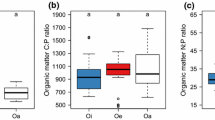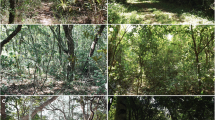Summary
The direct contribution made by soil arthropods to nutrient dynamics was investigated in pine forests that differed in soil nutrient status. Nutrient concentrations (K+, Ca2+, Mg2+, PO 3−4 , N, C) in the most abundant species and groups of arthropods in two Pinus nigra forests were compared, and distinct differences were found among taxonomic groups. In the rank order: collembolans, oribatides, isopods, diplopods, Ca2+ and Mg2+ concentrations increased, while N and C concentrations decreased. The nutrient concentrations in individuals of the same species but originating from the different forests were similar, except for the isopod Philoscia muscorum. The total and available nutrient concentrations in food and faeces of the collembolan Tomocerus minor and the isopod Philoscia muscorum were compared. The isopod faeces contained relatively less K+ and Mg2+, and more Ca2+, PO 3−4 , and greater N availability, compared with the food material. The collembolan faeces showed a higher availability of all nutrients measured. The N species appeared to be changed by collembolans; their faeces contained high NO −3 concentrations, while their food contained relatively high concentrations of NH +4 . These findings were examined in relation to their significance for ecosystem functioning. It was concluded that about 12% of the total K+, PO 3−4 , N and 2% of the Ca2+ in the organic layer was found in the mesofauna. It was calculated that faeces production by the collembolans resulted in a 2.4 times higher NO −3 availability in the forest floor.
Similar content being viewed by others
References
CarterA, CraggJB (1976) Concentrations and standing crops of calcium, magnesium, potassium and sodium in soil and litter arthropods and their food in an aspen woodland ecosystem in the Rocky Mountains (Canada). Pedobiologia 16:379–388
CarterA, CraggJB (1977) Potassium and calcium cycling by Eupterotegaeus rostatus (Acari: Cryptostigmata). Pedobiologia 17:169–174
DoeksenJ, Van derDriftJ (eds) (1963) Soil organisms North Holland Publ Co, Amsterdam
DungerW (1958) Über die Zersetzung der Laubstreu durch die Boden-Makrofauna in Auenwald. Zool Jahrb Syst 86:139–180
GhilarovMS (1971) Invertebrates which destroy the forest litter and ways to increase their activity. In: DuvigneaudP (ed) Productivity of forest ecosystems. Unesco, Paris, pp 433–442
HassallM, SuttonSL (1987) Immobilization of mineral nutrients by Philoscia muscorum (Isopoda, Oniscoidea) in a dune grassland ecosystem. In: StriganovaBR (ed) Soil fauna and soil fertility. Nauka, Moscow, pp 29–37
Janssen MPM (1991) Metal accumulation in soil arthropods in relation to micro-nutrients: Turnover of cadmium through soil arthropods. Ph D thesis, Free University, Amsterdam, pp 105–118
KendrickWB (1959) The time factor in the decomposition of coniferous leaf litter. Can J Bot 37:907–912
KirstenWJ (1979) Automatic methods for the simultaneous determination of carbon, hydrogen, nitrogen, and sulphur, and for phosphorus alone in organic and inorganic materials. Anal Chem 51:1173–1175
KrivolutzkyDA, PokarzhevskyAD (1977) Participation of soil invertebrates in the migration of ash elements. Pedobiologia 17:334–337
PetersenH, LuxtonM (1982) A comparative analysis of soil fauna populations and their role in decomposition processes. Oikos 39:287–388
RaffertyJ, NorlingR, TamaruR, McMathC, MorgansteinD (1985) Statworks, statistics with graphics for the Macintosh. Data Metrics Inc, Heyden and Son, London
ReichleDE (1971) Energy and nutrient metabolism of soil and litter invertebrates. In: DuvigneaudP (ed) Productivity of forest ecosystems. Unesco, Paris, pp 465–477
ReyesVG, TiedjeJM (1976) Ecology of the gut microbiota of Tracheoniscus rathkei (Crustacea, Isopoda). Pedobiologia 16:67–74
Roth-HolzapfelM (1990) Multi-element analysis of invertebrate animals in a forest ecosystem (Picea abies L.). In: LiethH, MarkertB (eds) Element concentration cadasters in ecosystems. VCH Verlagsgesellschaft, Weinheim, pp 281–295
SeastedtTR (1984) The role of microarthropods in decomposition and mineralization processes. Annu Rev Entomol 29:25–46
SeastedtTR, CrossleyDAJr (1983) Nutrients in forest litter treated with naphtalene and simulated throughfall: A field microcosm study. Soil Biol Biochem 15:159–165
TaylorCW (1986) Calcium regulation in insects. Adv Insect Physiol 19:155–186
TeubenA (1991) Nutrient availability and interactions between soil arthropods and microorganisms during decomposition of coniferous litter: A mesocosm study. Biol Fertil Soils 10:256–266
TeubenA, RoelofsmaTAPJ (1990) Dynamic interactions between functional groups of soil arthropods and microorganisms during decomposition of coniferous litter in microcosm experiments. Biol Fertil Soils 9:145–151
VanHookRI (1971) Energy and nutrient dynamics of spider and orthopteran populations in a grassland ecosystem. Ecol Monogr 41:1–26
VanStraalenNM (1985) Comparative demography of forest floor Collembola populations. Oikos 45:253–265
VanStraalenNM (1989) Production and biomass turnover in two populations of forest floor Collembola. Neth J Zool 39:156–168
VanStraalenNM, RijninksPC (1982) The efficiency of Tullgren apparatus with respect to interpreting seasonal changes in age structure of soil arthropod populations. Pedobiologia 24:197–209
VerhoefHA, PrastJE, VerweijRA (1988) Relative importance of fungi and algae in the diet and nitrogen nutrition of Orchesella cincta (L.) and Tomocerus minor (Lubbock) (Collembola), Functional Ecol 2:195–201
WallworkJA (1983) Soil fauna and mineral cycling. In: LebrunP (ed) New trends in soil biology. Dieu-Brichart, Louvain-La-Neuve, pp 29–33
WieserW (1968) Aspects of nutrition and the metabolism of copper in isopods. Am Zool 8:495–506
WoltersV (1985) Resource allocation in Tomocerus flavescens (Insecta, Collembola): A study with C-14-labelled food. Oecologia 65: 229–235
Author information
Authors and Affiliations
Rights and permissions
About this article
Cite this article
Teuben, A., Verhoef, H.A. Direct contribution by soil arthropods to nutrient availability through body and faecal nutrient content. Biol Fertil Soils 14, 71–75 (1992). https://doi.org/10.1007/BF00336253
Received:
Issue Date:
DOI: https://doi.org/10.1007/BF00336253




